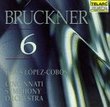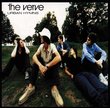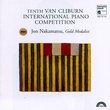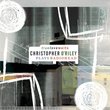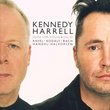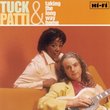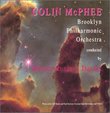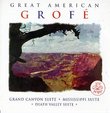| All Artists: Steven Stucky, Witold Lutoslawski, Esa-Pekka Salonen, Gloria Cheng Title: Piano Music of Salonen, Stucky & Lutoslawski Members Wishing: 0 Total Copies: 0 Label: Telarc Original Release Date: 1/1/2008 Re-Release Date: 7/22/2008 Genre: Classical Styles: Forms & Genres, Sonatas, Historical Periods, Classical (c.1770-1830), Modern, 20th, & 21st Century Number of Discs: 1 SwapaCD Credits: 1 UPC: 089408071225 |
Search - Steven Stucky, Witold Lutoslawski, Esa-Pekka Salonen :: Piano Music of Salonen, Stucky & Lutoslawski
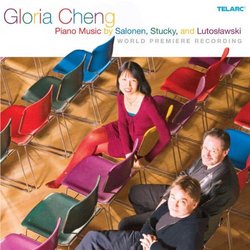 | Steven Stucky, Witold Lutoslawski, Esa-Pekka Salonen Piano Music of Salonen, Stucky & Lutoslawski Genre: Classical
Gloria Cheng, Piano Music of Salonen, Stucky & Lutoslawski |
Larger Image |
CD DetailsSynopsis
Album Description Gloria Cheng, Piano Music of Salonen, Stucky & Lutoslawski Similarly Requested CDs
|
CD ReviewsBrilliant program of surprising delights Ryan Morris | Chicago, IL | 10/22/2008 (5 out of 5 stars) "As far as I know[I do not have the booklet] this is the first recording of the Lutoslawski Piano Sonata. And what a debut it is!!! Its style might be considered like late Prokofiev's sonata's[a mix of the eight and nine] mixed in with an unexpected[for Luto] lyricism and beauty. This is obviously before Luto found his own voice, though there are hints of it. Regardless of anything external, this is a marvelous sonata, no matter who composed it, or when, or why. The other dominant work here is Dichotomie, composed by Esa-Pekka Salonen. Salonen has revealed himself to be a composer with an incredible ear for sonority, orchestration, and effect. Dichotomie is, basically a piano reduction of his orchestral work Foreign Bodies[an excellent and compelling work]. Again, I would suggest it has an affintiy to Prokofiev with its driving toccata-like rhythms, though on an entirely more complex level. I would be curious to know whether the orchestral FB came first, or this. It also reminds me of Stravinksy in a sense. Again, this is music that is connected, continous, and accessible-no blimp, bloop, disconnected chords smashes. Everyone can listen and enjoy. Salonen contributes two other pieces, YTA II and Three Preludes. The three preludes are interesting, though perhaps not as individual or initialy penetrating as Dichotomie or the Sonata. Of much interest to Salonen fans and also those who are loving the fact that good music is being written for the piano again. Some of my favourite works on this disc are Steven Stucky's Four Albums[scenes?}. Again, it is remarkable how consistent and interrelated this entire program is. It is astonishing and worthy of the highest praise that Cheng recognized the compatibility of Lutoslawski, Stucky, and Salonen, especially considering there is a forty year[or more] gap in the compositions. Recommended for all, especially those looking for new music to enjoy and for those who think that all new music is ugly or void of emotion or kitschy. And the playing is sensational. Bye." Easier listening than you'd think David Thierry | Chicago, IL United States | 01/29/2009 (4 out of 5 stars) "Really not difficult music at all. In fact, most of the pieces sound like Debussy which was a pleasant surprise. There are some pieces that sound more like Stravinsky in his neo-classical period. Very well played. I was quite pleased with the disc." Lovely piano pieces, though not among the composers' greates Christopher Culver | 01/31/2010 (3 out of 5 stars) "This 2008 disc features solo piano works by Esa-Pekka Salonen, Steven Stucky and Witold Lutoslawski performed by Gloria Cheng. My review will treat only the Salonen and Lutoslawski.
Esa-Pekka Salonen is represented by three pieces. The early "Yta II" (1985) shows the composer still following a European modernist path, with bleep-bloop textures. While Salonen soon entered a prolonged hiatus after which he repudiated modernism for its "taboos", this early work is still quite attractive. If you like Boulez's piano music or Magnus Linderg's very early pieces for the instrument, you'll feel right at home with "Yta II". Salonen's 3 Preludes for solo piano (2005) are related to his Piano Concerto of 2007, one of the most exciting concertos for the instrument written in our time (hear it with Yefim Bronfman on a fine DG disc). The first of the preludes, "Libellula meccanica" (Mechanical Dragonfly) features the fluttering theme heard thoughout the concerto, the following "Chorale" is reminiscent of the concerto's slow movement, while the last prelude "Invenzione a due voci" is similar to the turning point from the slow movement to the climax. Finally, Salonen's "Dichotomie" (2000) is a two-movement work for solo piano that contrasts "mechanical" material with "organic" material, a concern that Salonen has had through his entire career. It's catchy in parts, and its virtuosity is admirable, but I think it goes on a bit longer than necessary. "Dichotomie" was written for Gloria Cheng, though I prefer Yefim Bronfman's. Parts of "Dichotomie" found their way into Salonen's orchestral work "Foreign Bodies" (available on another DG disc). Witold Lutoslawski's Piano Sonata (1934) dates from the very start of the Polish composer's career, when he was still a student at the conservatory in Warsaw. Long thought lost, it was rediscovered after the composer's death and finally published in 2004. The sonata is in three movements, fast-slow-fast and lasts over 20 minutes. The sonorities are very French. This is an elegantly constructed work and imposes virtuoso demands throughout. However, as a fan of modernism, I'm rarely drawn to listen to any of Lutoslawski's works outside the 1950s to the early 1980s (the Concerto for Orchestra to the Symphony No. 3). None of the works here strike me as truly essential. However, Salonen's piano writing is always attractive, and the Lutoslawski is valuable at least as a document of the composer's development." |

 Track Listings (16) - Disc #1
Track Listings (16) - Disc #1

